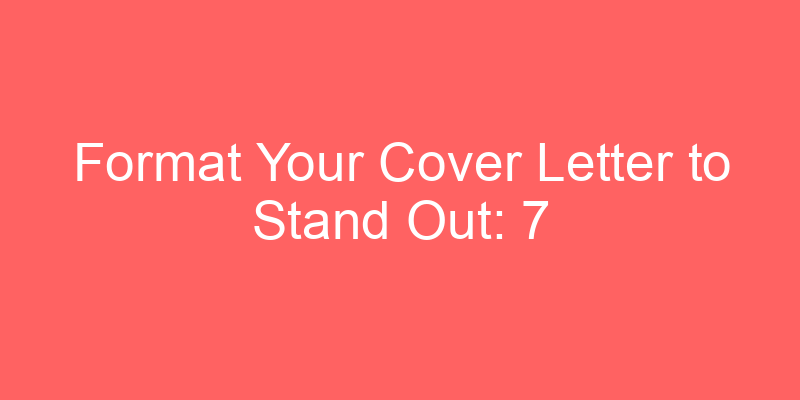How to Format Your Cover Letter to Stand Out in Your Job Search
Crafting the Perfect Introduction
When diving into the competitive job market, your cover letter serves as the first impression potential employers have of you. Start with a compelling opening that grabs attention and succinctly states your intention. For instance, sharing a brief anecdote related to your career journey can establish a personal connection right from the start.
Highlighting Your Skills and Experiences
Use this section to delve into your qualifications in detail. Rather than simply reiterating your resume, pick a few key accomplishments that directly relate to the job you’re applying for. Quantify your achievements where possible to demonstrate your impact. For example, instead of saying “Managed a team,” specify “Led a team of 10, achieving a 30% increase in project efficiency over 6 months.”
Showcasing Your Fit for the Role
Here’s your chance to connect the dots between your skills and the employer’s needs. Research the company thoroughly and align your experiences with their values and goals. Describe how your unique abilities can contribute to their success. This tailored approach proves you’ve invested time in understanding their business.
Formatting Tips to Impress
Formatting your cover letter professionally can significantly impact its readability and appeal. Here are some essential tips:
- Keep it concise: Aim for three to four paragraphs, avoiding unnecessary details.
- Use a clean layout: Choose a simple, readable font and maintain consistent spacing.
- Address it correctly: If possible, find out the hiring manager’s name and personalize your greeting.
Example of a Standout Cover Letter
Here’s an example of how these tips can come together:
Dear Ms. Johnson,
I was excited to learn about the opening for a Marketing Specialist at ABC Company. With five years of experience in digital marketing and a proven track record of increasing online engagement by 40%, I am confident in my ability to drive your brand’s growth initiatives.
In my previous role at XYZ Agency, I spearheaded a campaign that resulted in a 25% boost in lead generation, showcasing my strategic thinking and analytical skills. I am eager to bring my expertise in SEO and content strategy to ABC Company to achieve similar success.
Thank you for considering my application. I look forward to discussing how my skills align with your needs.
Sincerely,
John Doe
Conclusion: Stand Out and Succeed
Your cover letter is your chance to shine beyond your resume. By customizing it to each application and demonstrating your enthusiasm and qualifications, you significantly increase your chances of landing an interview. Remember, every word counts in presenting yourself as the ideal candidate.
How to Format Your Cover Letter to Stand Out in Your Job Search
Understanding the Importance of a Well-Formatted Cover Letter
When embarking on a job search, your cover letter serves as your first impression. It not only introduces you to potential employers but also showcases your personality and professionalism. A well-formatted cover letter can significantly enhance your chances of landing an interview.
Key Elements of an Effective Cover Letter
Effective cover letters are concise, tailored to the job description, and demonstrate a clear connection between your skills and the employer’s needs. They should include:
- Contact Information: Ensure your contact details are clearly visible at the top of the cover letter.
- Salutation: Address the hiring manager by name if possible, demonstrating your attention to detail.
- Introduction: State the position you are applying for and how you learned about it.
- Body Paragraphs: Highlight relevant skills, experiences, and achievements that align with the job requirements.
- Conclusion: Summarize why you are the ideal candidate and express your enthusiasm for the opportunity.
- Closing: Sign off professionally, such as “Sincerely” or “Best regards,” followed by your full name.
Formatting Tips for Your Cover Letter
The formatting of your cover letter plays a crucial role in its readability and impact. Follow these tips:
- Use a Professional Font: Choose a clean and easy-to-read font such as Arial, Calibri, or Times New Roman.
- Keep It Consistent: Maintain consistent formatting throughout, including font size and alignment.
- Optimize Length: Aim for a cover letter that is concise yet comprehensive, typically no more than one page.
- Use Bullet Points: Highlight key achievements or skills using bullet points to improve readability.
- Proofread: Eliminate any grammatical or spelling errors to present a polished document.
Common Mistakes to Avoid
To ensure your cover letter stands out for the right reasons, avoid these common pitfalls:
- Generic Content: Tailor each cover letter to the specific job and company rather than using a template.
- Overly Lengthy: Keep your cover letter concise and focused on your most relevant qualifications.
- Ignoring Instructions: Follow any specific instructions provided in the job listing regarding cover letter content or format.
- Lack of Customization: Personalize your cover letter to demonstrate your genuine interest in the position and company.
Conclusion
In summary, crafting a standout cover letter involves strategic formatting, clear communication of your qualifications, and a personalized approach to each application. By following these guidelines, you can create a compelling cover letter that enhances your job search efforts and captures the attention of hiring managers.
`
Generate Your NEXT Resume with AI
Accelerate your resume crafting with the AI Resume Builder. Create personalized resume summaries in seconds.




